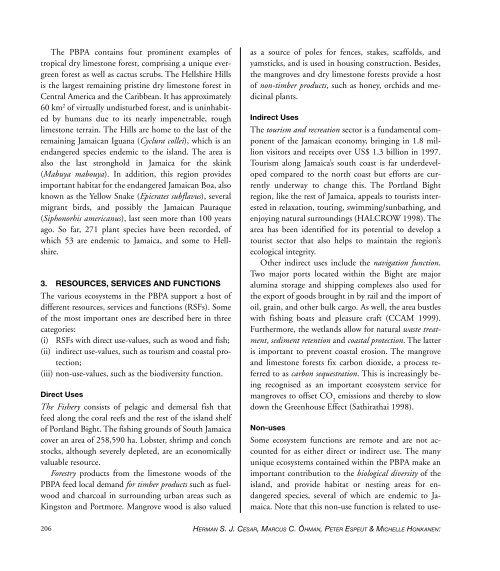You also want an ePaper? Increase the reach of your titles
YUMPU automatically turns print PDFs into web optimized ePapers that Google loves.
The PBPA contains four prominent examples <strong>of</strong><br />
tropical dry limestone forest, comprising a unique evergreen<br />
forest as well as cactus scrubs. The Hellshire Hills<br />
is the largest remaining pristine dry limestone forest in<br />
Central America and the Caribbean. It has approximately<br />
60 km 2 <strong>of</strong> virtually undisturbed forest, and is uninhabited<br />
by humans due to its nearly impenetrable, rough<br />
limestone terrain. The Hills are home to the last <strong>of</strong> the<br />
remaining Jamaican Iguana (Cyclura collei), which is an<br />
endangered species endemic to the island. The area is<br />
also the last stronghold in Jamaica for the skink<br />
(Mabuya mabouya). In addition, this region provides<br />
important habitat for the endangered Jamaican Boa, also<br />
known as the Yellow Snake (Epicrates subflavus), several<br />
migrant birds, and possibly the Jamaican Pauraque<br />
(Siphonorhis americanus), last seen more than 100 years<br />
ago. So far, 271 plant species have been recorded, <strong>of</strong><br />
which 53 are endemic to Jamaica, and some to Hellshire.<br />
3. RESOURCES, SERVICES AND FUNCTIONS<br />
The various ecosystems in the PBPA support a host <strong>of</strong><br />
different resources, services and functions (RSFs). Some<br />
<strong>of</strong> the most important ones are described here in three<br />
categories:<br />
(i) RSFs with direct use-values, such as wood and fish;<br />
(ii) indirect use-values, such as tourism and coastal protection;<br />
(iii) non-use-values, such as the biodiversity function.<br />
Direct Uses<br />
The Fishery consists <strong>of</strong> pelagic and demersal fish that<br />
feed along the coral reefs and the rest <strong>of</strong> the island shelf<br />
<strong>of</strong> Portland Bight. The fishing grounds <strong>of</strong> South Jamaica<br />
cover an area <strong>of</strong> 258,590 ha. Lobster, shrimp and conch<br />
stocks, although severely depleted, are an economically<br />
valuable resource.<br />
Forestry products from the limestone woods <strong>of</strong> the<br />
PBPA feed local demand for timber products such as fuelwood<br />
and charcoal in surrounding urban areas such as<br />
Kingston and Portmore. Mangrove wood is also valued<br />
as a source <strong>of</strong> poles for fences, stakes, scaffolds, and<br />
yamsticks, and is used in housing construction. Besides,<br />
the mangroves and dry limestone forests provide a host<br />
<strong>of</strong> non-timber products, such as honey, orchids and medicinal<br />
plants.<br />
Indirect Uses<br />
The tourism and recreation sector is a fundamental component<br />
<strong>of</strong> the Jamaican economy, bringing in 1.8 million<br />
visitors and receipts over US$ 1.3 billion in 1997.<br />
Tourism along Jamaica’s south coast is far underdeveloped<br />
compared to the north coast but efforts are currently<br />
underway to change this. The Portland Bight<br />
region, like the rest <strong>of</strong> Jamaica, appeals to tourists interested<br />
in relaxation, touring, swimming/sunbathing, and<br />
enjoying natural surroundings (HALCROW 1998). The<br />
area has been identified for its potential to develop a<br />
tourist sector that also helps to maintain the region’s<br />
ecological integrity.<br />
Other indirect uses include the navigation function.<br />
Two major ports located within the Bight are major<br />
alumina storage and shipping complexes also used for<br />
the export <strong>of</strong> goods brought in by rail and the import <strong>of</strong><br />
oil, grain, and other bulk cargo. As well, the area bustles<br />
with fishing boats and pleasure craft (CCAM 1999).<br />
Furthermore, the wetlands allow for natural waste treatment,<br />
sediment retention and coastal protection. The latter<br />
is important to prevent coastal erosion. The mangrove<br />
and limestone forests fix carbon dioxide, a process referred<br />
to as carbon sequestration. This is increasingly being<br />
recognised as an important ecosystem service for<br />
mangroves to <strong>of</strong>fset CO 2<br />
emissions and thereby to slow<br />
down the Greenhouse Effect (Sathirathai 1998).<br />
Non-uses<br />
Some ecosystem functions are remote and are not accounted<br />
for as either direct or indirect use. The many<br />
unique ecosystems contained within the PBPA make an<br />
important contribution to the biological diversity <strong>of</strong> the<br />
island, and provide habitat or nesting areas for endangered<br />
species, several <strong>of</strong> which are endemic to Jamaica.<br />
Note that this non-use function is related to use-<br />
206<br />
HERMAN S. J. CESAR, MARCUS C. ÖHMAN, PETER ESPEUT & MICHELLE HONKANEN:


















